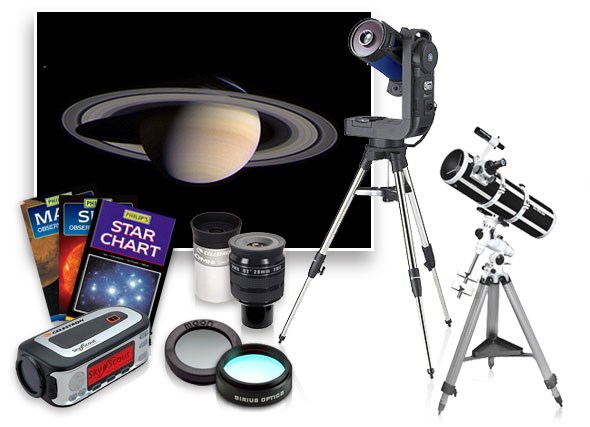
Starting out
Astronomy is one of the oldest of the Natural Sciences, if not the oldest, and one which can be taken up by practically anyone with very little knowledge or equipment from the outset. It’s a science, in which amateur astronomers can provide results of genuine interest and further the understandings of astronomy at large, and like all hobbies and past-times, it has a start place, and everyone has to start somewhere.
The object of this, the first of the Wex Guides to Astronomy, is to provide start point for people considering their first telescope or for those, whom already have one and wish to consolidate and expand their knowledge.
The guides will, as you read them, build and provide a good grounding in the basics of astronomy, its equipment and use, and without being overly technical by attempting to limit its readership to postgraduates or mathematical genii, and done so with a nod and a wink, and a gentle play of the hair towards humour. After all, astronomy isn’t all about intangible concepts and unapproachable societies; first and foremost it should be fun, awe-inspiring and the start of something better and bigger!
Hopefully by the end of these guides, you’ll have a better understanding and knowledge to buy your first telescope with confidence, or if you already own one, a greater understanding of how it works.
So roll up, be inspired, and get excited, as Astronomy is the new Rock and Roll! - It even has the ex-keyboard player of D:ream as its modern-day poster boy!
The Optical Assembly
So where do we start?
The “business end” of course, the meat and veg of the telescope, namely, the Optical Tube Assembly.
Now all optical telescopes operate on the principle of gathering as much light as possible, and in bringing the light into a common focus point whereby it can then be magnified by an eyepiece. This can be done in one of several ways depending on the tube’s optical design.
There are three designs in use pretty much exclusively nowadays and they are; Refractors, which use a lens to bring the light into common focus, Reflectors, which use mirrors, and Catadioptrics, which use a combination of lens and mirrors.
All three designs use what’s called a primary lens or mirror of a set diameter, to bring the light into the all-important ‘Common Focus Point’. This diameter becomes what is known as the telescopes aperture.
Now the first rule of thumb in buying a telescope is to remember the larger the aperture the more light the telescope will gather, and therefore the better the resolution and contrast of the resulting image.
- So as with most things in life, bigger is better, unless you’re talking about mortgages that is?
Now let’s have a closer look at each of the optical designs.
Refractors:
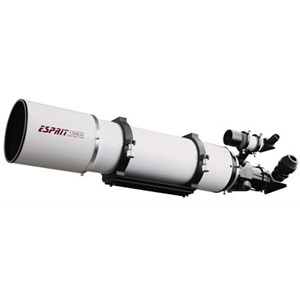
A refractor incorporates the simplest method to gather light. It has a lens at the front of its optical tube where the light is refracted to a focus point at the rear, where it can then be magnified.
Refractors can have one or several individual glass elements to make up its main primary lens, with benefits increasing as the more elements are used. By using more than one element, the lens can more accurately bring different wavelengths of light in to focus, thereby reducing colour (chromatic) aberration.
Because refractors can use several glass elements, each of which have to be precisely ground and polished, they are expensive size for size compared to reflectors. Refractors though, are considered the best at resolving the moon and planets (size for size), due to the fact they have no central obstruction. Also as they use a fixed lens there’s no collimation or dust issues within the optical tube assembly.
Reflectors:
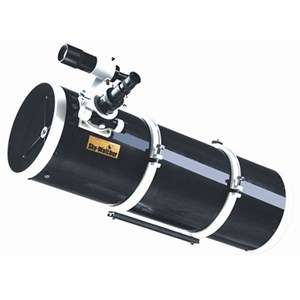
Reflectors use a concaved mirror as its primary, with the mirror diameter referring to its aperture.
The mirror is located at the back of the tube assembly, with the light entering from an open front end. The light is then reflected from the mirror, back up the tube to another “secondary” mirror set at 90 degrees, which reflects the light out through an opening and to the eyepiece.
The disadvantages of reflectors are that as they are an open tube system, dust on the primary mirror can become an issue, although to be fair, a layer of dust will only stop a minute fraction of a degree of light, so that unless the dust extremely bad, leave it. As dusting with the incorrect type cloth can do more damage than the dust itself.
Also due to their open tube assembly, differences in the air temperatures within the tube and the air outside, can cause convection cells, and reduce the “seeing”.
On the plus side and of most importance, large mirrors are less expensive to manufacture than complex lenses, so reflectors are far cheaper than refractors or Catadioptrics size for size, (Remember the bigger is better lesson?). Also, with reflectors no light is lost during the ‘gathering’ process (it reflects it all) as opposed to refractors, which unless a very expensive lens design is used, some light will be scattered, and to a degree lost.
Catadioptrics:
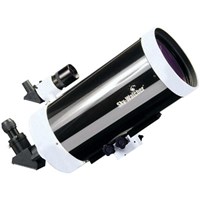
Now these clever fellers use a combination of a lens and mirrors, with the mirror being the primary. Light enters through a lens called a Correcting Plate at the front of the telescope, reflects off the mirror at the back, and is then reflected back down the tube by a smaller mirror fixed to the middle of the corrector plate. Now the benefit of Catadioptrics, having folded the light twice within its tube assembly, is that they’re the most compact and portable of the three designs. They are also considered a very good all-rounder for viewing most celestial objects, and have no internal dust issues. Their main downside being cost. They generally come out as the most expensive design, size for size what with all their ground glass and mirrors.
Secondary Accessories
OK, we've had a look at the Optical Tube Assemblies, their design and their respective advantages and disadvantages, so what goes with them? What comes with them to turn them from a collection of inanimate objects, into an inanimate “Window to the Universe”?
Telescopes are generally brought as a kit containing everything you need to get you going and are how most people will buy their first telescope. They will consist of a tripod and mount, the Optical Tube Assembly, and a host of other exciting parts all packaged up in small unobtrusive boxes.
So let’s have a look at these in a little more detail and familiarise ourselves with them.
Finder-Scope:
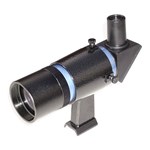
This small sighting scope attaches to the tube assembly, and is used as an aid in locating celestial objects.
Even looking through a low powered eyepiece, and unless you’re looking for the moon, the chance of you finding what you want to look at is slight to put it mildly, so a finderscope is employed to aid you in this task.
They all operate on the same principle regardless of their design which can be of a straight, 90 degree, or new-fangled red-dot finder.
In use, you first “Sight” the object in question through the finderscope, safe in the knowledge that you have previously aligned the finder to the optical tube assembly, and that once centred in the finders cross-hairs, you’ll move to your eyepiece and lo, the object in question should be in the middle of the field of view.
To align the finder to the telescope is a simple enough task and best done in daytime.
First locate and centre an object (not the Sun!) in a low powered eyepiece which is at least 500 meters away. Then simply direct the finderscope to the same object using the method for that particular design of finder, be it moving the cross-hairs, a red-dot, or the finder itself.
The Focuser:
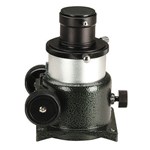
This isn’t an accessory as such but a vital part of a telescopes design, so warrants a few lines to describe it. In short, for refractors and reflectors it moves the diagonal or eyepiece holder along the focal plane so focus can be achieved for a particular individual, eyepiece or camera adaptor. Design is usually of a rack and pinion type, although some “draw-tube” designs can still be found in older telescopes. What to look for, is a smooth, slick action, and if possible with a dual-speed focuser.
In catadioptrics, the design is simpler where the primary mirror is generally moved back and forth via a small knob to change the distance of the focal point along the focal plane, and hence achieve focus.
In to the focuser will sit either, an eyepiece, eyepiece holder or diagonal of some flavour.
Diagonals:
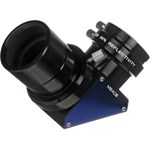
A diagonal (if required) is situated between the eyepiece or eyepiece holder, and the focuser and generally only used on refractors and catadioptric telescopes. Its function is mainly to aid comfort in viewing by reflecting the light coming out from the telescope by 45 or 90 degrees, therefore allowing a more suitable position for the observer when viewing for long periods. Diagonals are also available to “erect” an otherwise inverted image making the telescope suitable for terrestrial observations.
The Eyepiece holder:
Normally an integral part of a Diagonal or focuser, but can sometimes be a separate accessory supplied with a kit if required. In essence, does what it says it does. It securely locates and holds the eyepiece in the required correct position by a means of 2 or 3 tightening screws around a short barrel in which the eyepiece would sit.
Eyepieces:
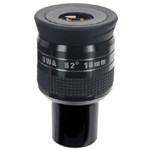
A vital element of the telescope, and effectively useless without them! They provide the all-important magnification of the image at the focal point, and come in many various designs and “strengths” of magnification. An eyepiece is generally referred by its focal length, which divided by the focal length of the telescope, will give a figure to the resulting magnification. An example being a 25mm eyepiece, being used on a telescope with a focal length of 1000m, therefore 1000/25= 40x magnification. The second part of an eyepiece name will be its optical design, be it a Plossl, Wide-Angle or Long Eye-Relief amongst many others, where each design would have different characteristics for differing applications. In general most kit lenses are the extremely good performing Super Plossl.
Tube-rings and Mounting bar:
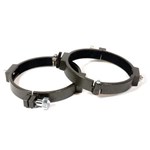
These simply allow for the attachment of the OTA to the mount, and are generally unexciting in themselves. But like all grand-scheme-of-things, are an essential part of the “whole”.
Tube rings fit around, and hold the OTA, to which is then bolted the Mounting Bar, which itself fits to a matching slot in the mount from where it can be fixed, much like a quick release plate on a photographic tripod. Mounting bars can also be directly fixed to the OTA on smaller, lighter tube assemblies.
Mount and tripod:
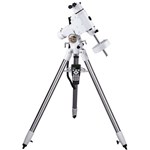
Now tripods generally get a lot of bad press, usually as the transportation method of choice for invading Martians, but in astronomy, they are vital. The mount and tripod can be thought of as the firm foundations of a telescope, and without firm foundations, well we all know the outcome to that! The tripod provides the support, height adjustment and weight-carrying role, with the mount providing the mounting and ability to move and adjust the telescopes orientation.
If you're buying a telescope as a kit, then the manufacturers will match it up with a suitable mount and tripod, and thankfully you may think no more on the matter. Unless that is, you’re looking to upgrade or buy one to make up a kit. In which case a little more consideration will be required prior to buying.
An easy way to think about the importance of the tripod, is to consider that the object your viewing has been magnified many times, and as such any vibration or movement within the mount and tripod will cause the object to dance around in the field of view until it settles, about 30 annoying seconds later. So to mitigate against this, a mount and tripod combination must be sought which is designed to support at minimum, the weight of your telescope set up. Unfortunately mount and tripods are not cheap, and there may be a temptation to go for a less expensive option, but this may come at a cost to your hair, as you increasingly pull it out waiting for that "dancing star" to settle again.
There are two flavours of mount used again pretty much exclusively nowadays, and they are the AZ, or Altazimuth, and the EQ, or Equatorial. Both come rated as to their weight supporting abilities from 1 to 6 with 1 being the smallest, least expensive and lightest load carrier, with 6 being the opposite.
The Altazimuth mount, is generally used on smaller, beginner scopes, or scopes which will also be used terrestrially. It has two axis of movement, horizontal and vertical enabling it to move in altitude and azimuth.
Equatorial mounts have a Right Accession and Declination axis and requires an initial set up for each viewing, when by they can then follow an object using movement in just one axis. With the advantages being for astrophotographers, and the ability to locate celestial objects using their coordinates.
(There will be a more detailed look at equatorial mounts in the second part of the Wex guides to astronomy).
Getting Outside
So, this brings us to the end guide. Hopefully now you will have a better understanding of your potential purchase, or the many bits laid out in front of you on your lounge floor as you assemble it.
The next step is the really exciting part, and forms the basis of the second Wex Guide to Astronomy - Buying, and using the thing! Although that of course won't be its title, so don't try looking for that, it'll be something far more esoteric or involving some witty pun, or maybe not... Either way, the truth is out there!

